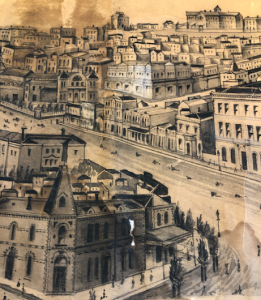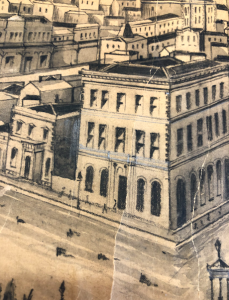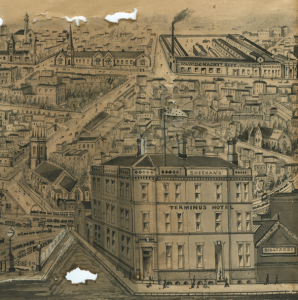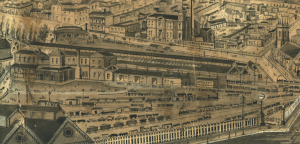
Place of great commerce and industry back in 1891, the old Geelong. For all the many glass-plate monochrome photo images that captured that activity, however, none quite match up to the pencil-and-ink efforts of artist-architect John Stuart Jackson.
Imagined from a birds-eye vantage near the Terminus Hotel on Mercer Street, he penned a 2.5-metre quasi-axonometric record of Geelong’s city centre, its waterfront, railway precinct, buildings, shops, smoking chimneys, roads, in almost bewildering complexity.
The diorama, in two fragile sections kept within the archives of the Geelong Heritage Centre, has been exhibited from time to time as five giant photo panels. The pentaptych is gob-smacking to say the least but so too the sepia-toned original.
Entitled Geelong from Sheehan’s Terminus Hotel 1891, the larger panorama has been exhibited at the National Wool Museum and for some time graced the councillors’ lounge at City Hall.
The images are exquisite in the detail but heavily stylised with an odd angular perspective and proportion that varies in no particular fashion. This allowed the artist to depict buildings individually, rather than partially, hidden behind others. Little wonder so many fountains, rooftops, steeples, windows galore, a billiards room, even a brewery, jump out boldly at the viewer.


The artist Jackson himself, while a well-connected entrepreneur in the day, is a somewhat mysterious figure who came to Australia with his parents in the mid-1870s.
He served as president of Geelong’s agricultural society and amateur dramatic arts clubs. He worked as an architect, designed alterations to make the Exhibition Building a theatre, built the Anglesea Hotel and worked on numerous other projects. He married Alice Parker, daughter of Geelong ironmonger Richard Parker.
Jackson’s finances soured, however, and he was declared insolvent in 1889. He was arrested over a bad cheque in 1890 and the following year moved to Perth, leaving his wife this side of the country, running hotels at Anglesea and Torquay.


Money had to be subscribed by his friends to tide him over on his arrival but once ensconced in Perth, he set about drafting a similarly-styled cyclorama of that city, taking several months to complete the work which is now with the WA State Library.
Like the Geelong work, it’s also an insight into how the swan city looked from an elevated perspective, with close-ups of buildings and properties showing its institutions, businesses and individuals of the time.
This article appeared in the Geelong Advertiser 12 September 2022
Images: Courtesy Kim barne thaliyu / Geelong Heritage Centre Archives.


